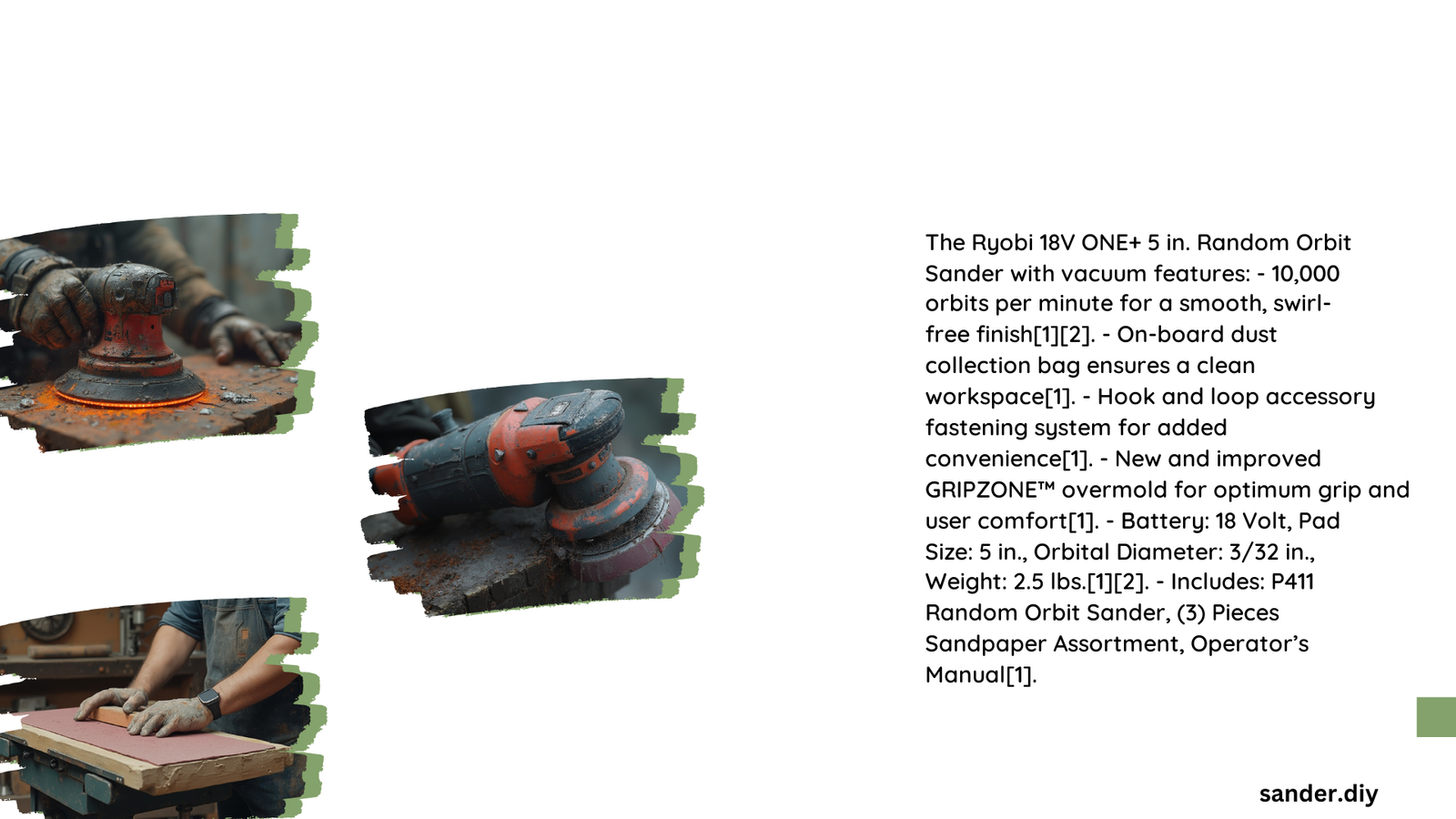The Ryobi orbital sander with vacuum is a versatile power tool designed for efficient sanding and dust collection. Available in both corded and cordless models, this sander features a 5-inch pad size and operates at high orbital speeds. The integrated vacuum system helps maintain a clean work area by collecting dust and debris during operation. With its ergonomic design and effective dust management, the Ryobi orbital sander is suitable for various woodworking and DIY projects.
What Are the Key Specifications of the Ryobi Orbital Sander with Vacuum?
The Ryobi orbital sander comes in two main variants:
- Corded Model:
- Power Rating: 2.6-Amp motor
- Orbital Speed: 12,500 orbits per minute (OPM)
-
Weight: 3.5 lbs
-
Cordless Model (18V ONE+):
- Power Rating: 18V battery-powered
- Orbital Speed: 10,000 OPM
- Weight: 2.5 lbs
Both models feature a 5-inch pad size, making them suitable for a wide range of sanding applications.
How Effective Is the Vacuum Attachment?

The vacuum attachment on the Ryobi orbital sander is designed to minimize airborne particles and keep the work area clean. Here are some key points about its effectiveness:
- Compatible with both on-board dust collection bags and external vacuum systems
- Dust collection ports compatible with 1-1/4\” and 1-7/8\” hoses (18V ONE+ model)
- Effective for both wood and metal sanding
- User reports vary depending on the material and grit of sandpaper used
While the vacuum system is generally effective, some users have reported occasional issues with dust bag clogging or reduced suction over time, particularly with finer dust particles.
What Are the Advantages of the Dust Collection System?
The dust collection system on the Ryobi orbital sander offers several advantages:
- Reduced airborne particles
- Cleaner work environment
- Improved visibility of the work surface
- Less frequent need to clean up after sanding
- Potential health benefits by reducing dust inhalation
The system is designed to capture a significant amount of dust and debris, although specific filtration efficiency metrics are not provided by the manufacturer.
How Does the Ryobi Orbital Sander Perform According to User Reviews?
User reviews of the Ryobi orbital sander with vacuum are generally positive. Here’s a breakdown of common feedback:
| Aspect | User Feedback |
|---|---|
| Overall Rating | Typically 4.5 to 4.8 out of 5 stars |
| Sanding Efficiency | Improved efficiency reported by many users |
| Finish Quality | Enhanced finish quality noted, especially with vacuum use |
| Dust Collection | Generally effective, with some reports of occasional clogging |
| Ease of Use | Praised for ergonomic design and lightweight nature |
Users often note that the vacuum feature helps maintain a clean work surface and reduces the need for frequent sandpaper changes due to dust buildup.
What Are the Common Challenges Users Face with This Sander?
While the Ryobi orbital sander with vacuum is generally well-received, some users have reported challenges:
- Dust bag clogging: Some users experience clogging, especially with fine dust particles.
- Suction loss: Occasional reduction in suction power, particularly if the dust bag is not emptied regularly.
- Vacuum hose connection: Proper connection of the vacuum hose is crucial for optimal performance.
- Battery life (for cordless model): Some users wish for longer battery life during extended use.
To mitigate these issues, regular maintenance and proper use of the dust collection system are recommended.
How Does the Ryobi Orbital Sander Compare to Other Brands?
When comparing the Ryobi orbital sander with vacuum to other brands, several factors stand out:
- Price point: Generally more affordable than premium brands
- Versatility: Part of the ONE+ system, allowing battery interchangeability (cordless model)
- Performance: Competitive orbital speeds and sanding efficiency
- Dust collection: On par with many competitors, with the added benefit of vacuum attachment options
While it may not have all the features of high-end professional models, the Ryobi orbital sander offers good value for DIY enthusiasts and hobbyist woodworkers.
What Are the Best Practices for Using the Ryobi Orbital Sander with Vacuum?
To get the most out of your Ryobi orbital sander with vacuum, consider these best practices:
- Empty the dust bag regularly to maintain optimal suction.
- Use the appropriate grit sandpaper for your project to minimize dust generation.
- Ensure proper connection of the vacuum hose or dust bag before use.
- Clean the dust collection ports periodically to prevent clogging.
- For the cordless model, keep spare batteries charged for uninterrupted work.
- Apply even pressure while sanding to achieve the best finish and prolong sandpaper life.
By following these practices, you can maximize the efficiency and effectiveness of your Ryobi orbital sander with vacuum.
In conclusion, the Ryobi orbital sander with vacuum offers a balance of performance, dust management, and affordability. While it may have some limitations, it remains a popular choice for many DIY enthusiasts and hobbyist woodworkers looking for an effective sanding solution with integrated dust collection.
References:
1. Ryobi Tools Support
2. Ryobi Tools Canada
3. Ryobi Tools
